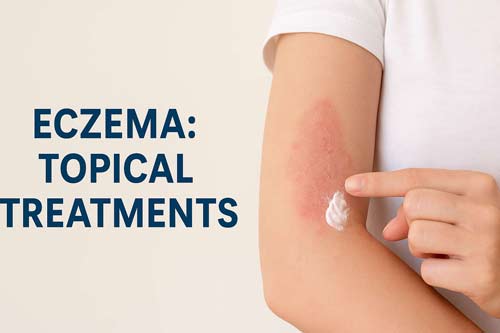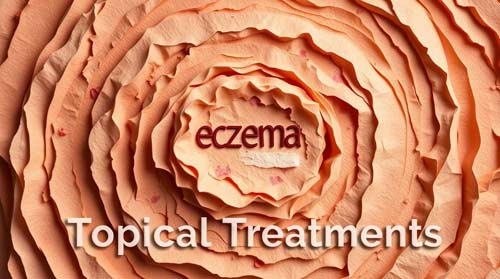Eczema: Topical Treatments

Overview
Eczema is recognized as the most burdensome skin condition globally, often managed with topical anti-inflammatory treatments. However, the comparative effectiveness and safety of these treatments remain unclear.
A network meta-analysis was conducted within a Cochrane systematic review to assess and statistically rank the efficacy and safety of various topical anti-inflammatory options for eczema.
The analysis incorporated data from the Cochrane Skin Specialized Register, CENTRAL, MEDLINE, Embase, and trial registries up to June 2023. The trials selected were either within-participant or between-participant randomized controlled trials, involving participants with eczema that was neither clinically infected nor associated with contact dermatitis, seborrheic eczema, or hand eczema. The interventions included topical anti-inflammatory treatments, excluding complementary therapies, antibiotics, wet wraps, phototherapy, or systemic treatments. Comparators were either no treatment, vehicle treatments, or other topical anti-inflammatories.
A total of 291 trials were identified, comprising 45,846 participants, predominantly from high-income countries. Most trials were industry-funded, with a median treatment duration of three weeks. The risk of bias, evaluated using the Cochrane Risk of Bias 2.0 tool, was high in 89% of the studies, primarily due to the potential for selective reporting. The network meta-analysis of binary outcomes revealed that potent and very potent topical steroids, as well as tacrolimus 0.1% and ruxolitinib 1.5%, ranked among the most effective treatments for enhancing patient-reported symptoms (based on 40 trials, all with low confidence) and clinician-reported signs (32 trials, all with moderate confidence). In terms of investigator global assessment, Janus kinase inhibitors like ruxolitinib 1.5%, delgocitinib 0.5% or 0.25%, alongside very potent/potent topical steroids and tacrolimus 0.1%, were similarly ranked as the most effective (140 trials, all with moderate confidence).
Continuous outcome data yielded mixed results. Local application site reactions were most frequently observed with tacrolimus 0.1% (moderate confidence) and crisaborole 2% (high confidence), while they were least common with topical steroids (moderate confidence). Short-term use of any topical steroid potency did not significantly increase the risk of skin thinning (low confidence), although skin thinning was reported in 6 of 2044 participants (0.3%) receiving long-term topical steroid treatment (6–60 months). Potent topical steroids, Janus kinase inhibitors, and tacrolimus 0.1% were consistently identified as among the most effective topical anti-inflammatory treatments for eczema.
Introduction
Eczema is a prevalent skin condition that affects up to 20% of infants, 6% of school-age children, and 5% of adults worldwide, making it the most burdensome skin disorder globally. Topical corticosteroids (TCS) have been the primary anti-inflammatory treatment for eczema for over 70 years. While there is significant interest in developing new systemic treatments for moderate to severe cases, several new classes of topical anti-inflammatory treatments have also been approved for use in varying degrees of eczema severity. Notable among these are topical calcineurin inhibitors (TCIs) like tacrolimus and pimecrolimus, which were approved in 2000, along with phosphodiesterase 4 (PDE-4) inhibitors, such as crisaborole, Janus kinase (JAK) inhibitors like ruxolitinib, and aryl hydrocarbon receptor activators, including tapinarof, which are either available or under development. Despite the availability of these treatments, there is a lack of comparative effectiveness research in eczema management, complicating the decision-making process for healthcare providers and patients regarding the most beneficial and least harmful treatments. This gap also poses challenges for the development of clinical guidelines. To address this issue, we conducted a network meta-analysis (NMA) focused on the effectiveness and safety of various topical anti-inflammatory treatments for eczema. This approach aims to provide a statistical ranking and comparison of these treatments to enhance decision-making in clinical practice.
Method
This systematic review and network meta-analysis (NMA) adhered to the standard Cochrane methodology, following a pre-published protocol and statistical analysis plan. It focused on randomized controlled trials (RCTs) involving participants of any age diagnosed with eczema (atopic dermatitis) of varying severity. Trials specifically targeting non-atopic eczema types—such as contact dermatitis, hand eczema, or seborrheic eczema—and clinically infected eczema were excluded. The review considered interventions involving well-defined topical anti-inflammatory treatments while excluding emollients, topical antibiotics, complementary therapies, wet wraps, systemic treatments, and phototherapy. Non-standard treatment regimens were also excluded, particularly those involving less than once daily or more than twice daily applications, or treatment durations shorter than one week. The comparisons were made against other topical anti-inflammatory treatments, placebo, or no treatment. Topical corticosteroids (TCS) were categorized into mild, moderate, potent, or very potent as per previous classifications. The outcomes prioritized for evaluation were informed by the Harmonising Outcome Measures for Eczema (HOME) initiative and reflected input from patients and the public during preliminary workshops.
Primary Outcomes
- Patient-reported symptoms: Data were gathered using the Patient-Oriented Eczema Measure (POEM) or alternative instruments if POEM was unavailable, focusing primarily on pruritus.
- Clinician-reported signs: Data extraction was based on the Eczema Area and Severity Index or other preferred instruments, treating the Investigator Global Assessment (IGA) separately.
Secondary Outcomes
- Health-related quality of life: Evaluated through the Dermatology Life Quality Index, including versions for children and infants, with alternatives if necessary.
- Long-term control of eczema: Assessed using the Recap of Eczema Control or similar tools when appropriate. Local adverse effects prioritized during patient involvement work were also noted.
The review involved a comprehensive search of several databases, including the Cochrane Skin Specialised Register, CENTRAL, MEDLINE, Embase, and clinical trial registries up to June 2023. The NMA utilized a frequentist approach consistent with the Cochrane Handbook for Systematic Reviews. The analysis followed a predefined statistical analysis plan, employing planned networks for evaluating both patient-reported and clinician-assessed outcomes across different timeframes. Specific analyses were conducted for safety outcomes. A random-effects model was used to summarize data as odds ratios or standardized mean differences, utilizing Stata software for statistical operations and heterogeneity assessment. The risk of bias for the included trials was evaluated using the Cochrane risk of bias tool, while the certainty of evidence was determined using the Confidence In Network Meta-Analysis (CINEMA) approach. Although the primary analyses were intended to include only low-risk bias data, due to insufficient low-risk data, analyses were conducted on all available data, complemented by sensitivity analyses where feasible. Additionally, subgroup analyses examined the effects based on application site, disease severity, and participant age. Summary of Findings Tables were produced for outcomes where NMA was viable, incorporating only licensed topical anti-inflammatory interventions applied at approved concentrations. Further methodological details can be found in the Cochrane review protocol.

Results
The search results, depicted in Figure 1, are reported in alignment with the PRISMA guidelines and the NMA extension. A total of 291 trials, involving 45,846 participants, with published outcomes addressing various levels of eczema severity were identified. Additionally, 120 trials were noted as either ongoing (95) or unclassifiable (25). The majority of trials were conducted in high-income countries, particularly in Europe and North America, with 189 taking place in secondary care settings. Most participants were adults, with only 31 trials specifically focused on children under 12 years. While the trials included both male and female participants from various ethnic backgrounds, predominantly white populations were represented.
Funding sources were disclosed in 199 trials as industry-funded, while 85 trials did not report their funding status. The median duration for treatment and participation in the trials was 21 days and 28 days, respectively, ranging from 7 days to 5 years. The interventions studied included topical corticosteroids (TCS) (172), topical calcineurin inhibitors (TCI) (134), phosphodiesterase-4 (PDE-4) inhibitors (55), Janus kinase (JAK) inhibitors (30), aryl hydrocarbon receptor activators (10), and other topical agents (21). Comparators primarily consisted of a vehicle (170) or alternative anti-inflammatory treatments.
Risk of bias assessment is summarized in Figure 3, revealing a high risk of bias in 242 out of 272 (89%) trials that contributed data for analysis. The predominant bias was related to selective reporting, particularly the absence of prospective trial registration or protocol availability. Other noted concerns included insufficient information regarding allocation concealment, contamination in within-participant trials, inadequate reporting of randomized participant numbers in outcome analyses, exclusions from analysis for potentially inappropriate reasons (such as adverse events), and high proportions of missing randomized participants in analyses.
The NMA incorporated 40 trials (n = 6482) primarily reporting a ≥4-point improvement on the Peak Pruritus Numerical Rating Scale. Potent TCS, the TCI tacrolimus 0.1%, and the JAK inhibitor ruxolitinib 1.5% emerged as the most effective interventions. In contrast, mild TCS and PDE-4 inhibitors such as roflumilast 0.15% and crisaborole 2% were noted to be the least effective. Most confidence intervals were broad and overlapping, with CINeMA ratings mostly low or, in some cases, moderate. The analyses included subgroup and sensitivity evaluations, narrative details, and continuous outcome assessments for patient-reported eczema symptoms, with findings generally consistent with the main binary analysis.
The NMA for clinician-reported eczema signs included 32 trials (n = 4121), typically reporting a ≥75% improvement on the Eczema Area and Severity Index. Potent TCS (OR 8.15, 95% CI 4.90, 13.57), the TCI tacrolimus 0.1% (OR 8.06, 95% CI 3.30, 19.67), and JAK inhibitors like ruxolitinib 1.5% (OR 7.72, 95% CI 4.92, 12.10) were ranked among the most effective interventions. Meanwhile, mild TCS (OR 2.22, 95% CI 0.74, 6.64), PDE-4 inhibitors such as roflumilast 0.15% (OR 2.43, 95% CI 0.88, 6.70), and crisaborole 2% (OR 2.98, 95% CI 1.42, 6.26) were considered less effective. Confidence intervals were generally wide and overlapping, but most CINeMA ratings were moderate or high. The analyses included subgroup and sensitivity evaluations, and findings were generally consistent with the primary clinician-reported eczema signs analysis.
The NMA comprised 140 trials (n = 23,383) primarily assessing the proportion of participants with ‘clear or almost clear’ eczema via a 6-point Investigator Global Assessment. Potent TCS (OR 5.00, 95% CI 3.80, 6.58), very potent TCS (OR 8.34, 95% CI 4.73, 14.67), and JAK inhibitors such as ruxolitinib 1.5% (OR 9.34, 95% CI 4.80, 18.18) were identified as highly effective. Mild TCS (OR 1.38, 95% CI 0.94, 2.02) and PDE-4 inhibitors (roflumilast 0.15%, OR 2.43, 95% CI 0.65, 9.01; crisaborole 2%, OR 2.14, 95% CI 1.22, 3.76) were found to be the least effective. Similar to previous findings, confidence intervals were wide, and CINeMA ratings were predominantly low or moderate. Sensitivity analysis for low risk of bias data indicated that potent TCS and JAK inhibitors delgocitinib 0.5% and delgocitinib 0.25% were the most effective, while pimecrolimus 1% and PDE-4 inhibitors were the least effective.
The NMA examined 83 trials (n = 18,992) reporting tolerability events, such as burning, stinging, or irritation reactions. The TCIs tacrolimus 0.1% and 0.03%, pimecrolimus 1%, and the PDE-4 inhibitor crisaborole 2% were identified as the most likely to cause application site reactions, while mild to very potent TCS were least likely to do so. Wide confidence intervals were common, with CINeMA ratings predominantly low or moderate, though crisaborole 2% received high ratings. Subgroup and sensitivity analyses corroborated the main findings.
The NMA incorporated 25 trials (n = 3691, 36 events) assessing skin thinning, atrophy, striae, or telangiectasia. No significant increase in the odds of skin thinning or atrophy was observed with any potency of TCS or TCIs (tacrolimus 0.1% and pimecrolimus 1%) compared to vehicle. CINeMA ratings were low across all comparisons, attributed to within-trial bias and imprecision. Longer-term data on this outcome were limited, but a few trials suggested a potential increase in long-term skin thinning with TCS compared to TCI.
The NMA could not be performed for health-related quality of life or long-term control outcomes due to insufficient data. Analysis of pigmentary changes (8 trials of TCS and a PDE-4 inhibitor, n = 1786, 3 events) revealed no significant increase in pigmentation changes compared to vehicle. Additionally, NMA regarding withdrawal due to short-term adverse events (11 trials, n = 2404) did not show significant differences in withdrawal rates across interventions compared to vehicle, indicating low confidence in the findings. There remains a notable gap in long-term safety data for these interventions.

Conclusion 
This Cochrane systematic review and network meta-analysis (NMA) examined the effectiveness of topical anti-inflammatory treatments for eczema. The analysis identified potent topical corticosteroids (TCS), Janus kinase (JAK) inhibitors, and tacrolimus 0.1% as the most effective treatments. However, confidence in these findings was rated low to moderate due to issues like selective reporting, which hindered a reliable ranking of the comparative effectiveness of these treatments.
Safety data were limited, with local application site reactions reported most frequently for tacrolimus 0.1% and the phosphodiesterase-4 (PDE-4) inhibitor crisaborole 2%. While short-term use of various TCS did not significantly increase the risk of skin thinning, a small percentage of participants (0.3%) experienced this adverse effect after long-term treatment (6 to 60 months).
The review primarily addressed short-term treatment outcomes for non-severe eczema in adults in high-income countries. There is a pressing need for further research to evaluate long-term outcomes, effectiveness, and safety in young children, who are most commonly affected by eczema, and in low- to middle-income countries. Some recent studies indicate that while intermittent mild to moderate TCS did not adversely affect growth in young children over five years, significant growth suppression occurred with proactive use of potent TCS in infants with eczema.
Although cost-effectiveness was not formally evaluated, it was noted that newer treatments like topical calcineurin inhibitors (TCIs), JAK inhibitors, PDE-4 inhibitors, and aryl hydrocarbon receptor (AHR) activators are generally 4 to 20 times more expensive per gram than TCS. The findings align broadly with existing literature, including a recent NMA on topical anti-inflammatory treatments for eczema, though some differences in efficacy rankings and adverse event outcomes were noted due to variations in inclusion criteria and methodologies between the studies.
Concerns regarding bias and selective reporting were prevalent, with insufficient low-risk bias information available for key outcomes, despite the review of 291 trials involving 45,846 participants. This lack of transparency in reporting contrasts with a Cochrane review on eczema prevention using moisturizers, which exhibited a higher level of completeness in outcome reporting. Improved trial registration and reporting standards are essential for strengthening the evidence base for topical eczema treatments.
The review also highlighted issues with the reporting of trial outcomes, as many studies did not provide sufficient data for inclusion in the NMA. A notable limitation was the inconsistent reporting of eczema severity across studies, which complicated the assessment of network intransitivity. In conclusion, this NMA found potent TCS, JAK inhibitors, and tacrolimus 0.1% to be statistically ranked as the most effective short-term treatments for eczema, albeit with varying confidence levels. Local reactions were most common with tacrolimus 0.1% and crisaborole 2%, while the risk of skin thinning with TCS was minimal. Further investigations are warranted to explore the long-term effects of these treatments, particularly in pediatric populations.


